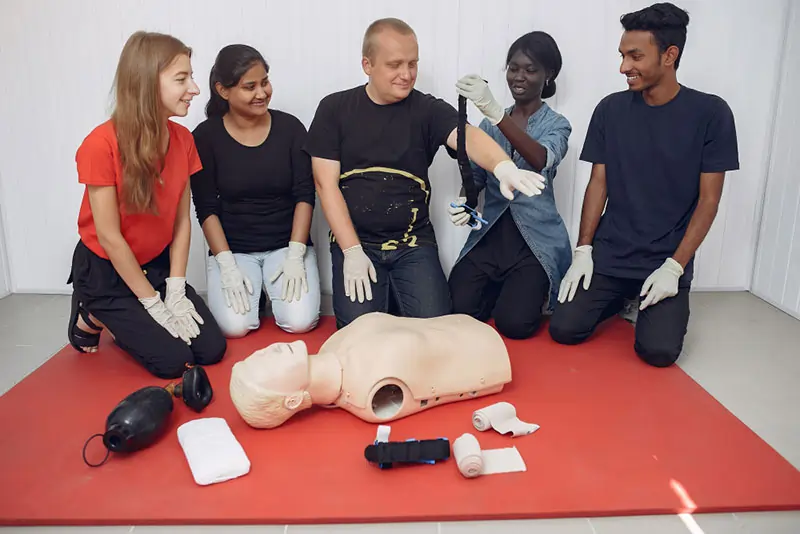What You Need to Know About CPR Training

Cardiopulmonary resuscitation is a lifesaving emergency procedure. It refers to the process where a person’s heart stops beating or they stop breathing. It involves chest compressions and rescue breathing that provide a life-sustaining force and oxygen in vital parts. It is administered until advanced medical aid arrives. Thus, CPR training equips people to respond appropriately and could save lives. It also raises the survival opportunity of patients that experience a cardiac arrest. Here is what you should know about CPR training:
Importance of CPR
CPR is critical because it offers instant care when there are emergencies. It ensures the good flow of blood and oxygen to the main organs. Without proper CPR, chances of survival are reduced to 7-10% when cardiac arrest occurs. Proper and prompt execution of CPR can double and triple the probability of survival in a person. Since cardiac arrest can arise at any place, not inside the hospital, knowledge of CPR can be helpful. Till assistance reaches the victim, CPR bridges that period between a confirmed cardiac arrest and reaching the hospital, which may save the person.
Components of CPR Training
The procedures that you will learn upon enrolling in a CPR class are really quite extensive. The three main components of CPR training are chest compressions, rescue breaths, and the use of automated external defibrillators (AEDs). Each component is likely to enhance the survival probability.
Chest Compressions
This is the principle of CPR. This involves pushing down firmly and rapidly in the midst of the chest. For adults, these compressions should reach at least 2 inches deep and performed at 100-120 compressions per minute. Consistency in such high-quality compressions must be ensured.
Rescue Breaths
It is crucial to allow oxygen into the victim’s lungs. It is used in cases of drowning, drug overdose, etc. In all such circumstances, there is a significant problem of oxygen deprivation. For every 30 compressions, two rescue breaths are given. Carry out the following: Open the airway by holding up the victim’s head. Pinch the nose and push your mouth onto the victim’s mouth, thus pushing the chest upwards.
Automated External Defibrillators (AEDs)
AEDs are portable devices that administer a shock to the heart that assists in the restoring of an effective rhythm, applied in cases of sudden cardiac arrest. AEDs have been engineered to be user friendly. Training includes recognizing when an AED is required and how to apply an AED.
Types of CPR Training
CPR training is made to meet the needs of different scenarios. The main types of CPR courses that are usually available are:
Adult CPR
This program covers all those people who will eventually be required to be prepared to respond to cases of adult cardiac emergencies. They are trained on how to perform the rescuer chest compression and rescue breath in adults. They also teach them how to identify cardiac arrest and use an AED.
Related reading: Why Cardio Health Is Important: Best Supplements For Cardio
Child and Infant CPR
This course is designed for parents and caregivers of children and infants. Children’s anatomical differences make CPR training different from those of adults. It focuses on two-finger chest compressions, gentle rescue breaths, and specialized airway management techniques.
Hands-Only CPR
It is ideal for untrained bystanders or individuals seeking quick CPR training. This course focuses solely on chest compressions.
Professional Rescuer CPR
Professional Rescuer CPR is a course intended to reach healthcare professionals, first responders, and medical professionals. It deals with advanced airway management, two-rescuer CPR, as well as other advanced techniques. BLS certification is also often required for most health careers and expires after two years.
What to Expect in a CPR Class
Attending a CPR class equips you with vital skills to respond to cardiac emergencies. It is usually for two to four hours. Here’s what you can expect:
- The instructor outlines the course goals, including the importance of CPR and what you’ll achieve by the end of the class—key components of a comprehensive first aid course designed to equip you with lifesaving skills.
- You will learn how to differentiate between heart attacks and cardiac arrests. It discusses early recognition of signs, immediate CPR, rapid defibrillation, and advanced care.
- Practice proper hand placement, compression depth, and rate on manikins, often with feedback devices for real-time guidance.
- Understand how an AED works and practice using it. This includes learning how the pads are placed and also following the automated prompts.
- Engage in realistic scenarios to assess situations, call for help, perform CPR, and use an AED.
- Show your practice skills and complete a written exam to receive certification.
You can earn CPR certification after completing a training course and is valid for two years. After that, individuals need to recertify themselves through shorter courses.
Related reading: Essential First Aid Items You Should Have In Your Car
Wrapping Up
In conclusion, CPR training is a skill that helps individuals respond to emergencies. By learning CPR techniques, individuals can increase the survival of victims. Attending a CPR class provides hands-on practice and scenario-based training. The benefits of being CPR-certified include the ability to act in emergencies. The survival rates increase with more widespread knowledge. It increases the capability to save lives, including those of loved ones. Investing a few hours in CPR training can empower you to take decisive action. It also provides essential care during critical moments.



